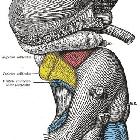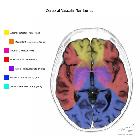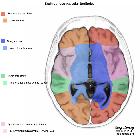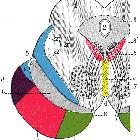Medulla











The medulla oblongata (or simply the medulla) is the most caudal part of the brainstem between the pons superiorly and spinal cord inferiorly. It is the transition from the spinal cord to the brain.
The medulla contains the vital autonomic cardiovascular and respiratory centers controlling heart rate, blood pressure, and breathing. It is composed of grey matter, cranial nerve (CN) nuclei IX to XII, and white matter tracts .
Gross anatomy
The medulla is approximately 3 cm in length and 2 cm in greatest diameter . The caudal border of the medulla is the 1st cervical spinal nerves. The superior broad part of the medulla joins the pons .
Medulla is separated into two main parts:
- ventral (anterior) medulla which contains the olive, pyramidal tracts, and CN IX to XII rootlets
- tegmentum (dorsal) medulla which contains several cranial nerve nuclei and white matter tracts
Ventral medulla
Pyramids are paired structures located at the medial aspect of the ventral medulla and flank the anterior median fissure. They contain the anterior and lateral corticospinal tracts. At the caudal end of the pyramids, the corticospinal tracts decussate .
Olivary bodies are paired structures located at lateral aspect of ventral medulla, lateral to the pyramids. They are separated from the pyramids by an anterolateral sulcus (pre-olivary sulcus). There is also a post-olivary sulcus lateral to the olivary bodies. Olivary bodies contain the superior and larger inferior olivary nuclei .
Medulla tegmentum
The dorsal aspect of the medulla contains the posterior median sulcus (most dorsal medial sulcus) and the more lateral posterolateral sulcus. Between these sulci are the fasciculus gracilis and nuclei forming the gracilis tubercle medially and the fasciculus cuneatus and nuclei forming the cuneate tubercle laterally .
Superiorly the dorsal surface of the medulla is slightly depressed, forming the diamond-shaped rhomboid fossa which is the floor of the fourth ventricle. The superior dorsal aspect of the medulla is occupied by the inferior cerebellar peduncle situated between the lower part of the fourth ventricle. The inferior dorsal and lateral aspect of the medulla is surrounded by the cisterna magna (posterior cerebellomedullary cistern), and lateral cerebellomedullary cistern .
The median aperture (foramen of Magendie) and the more superior lateral apertures (foramina of Luschka) open at the level of the pons, with the canals projecting to the level of the medulla region and terminating into the cisterna magna and lateral cerebellomedullary cistern respectively .
Cranial nerves
The nuclei of the cranial nerves in the medulla originate in the tegmentum, but the nerve roots exit ventrally. Cranial nerves IX and X as well as the roots of XI exit the lateral medulla at the post-olivary sulcus, posterior to olivary bodies. Cranial nerve XII emerges between the pyramid and the olive at the pre-olivary sulcus as a number of rootlets .
Blood supply
- posterior inferior cerebellar artery (PICA) supplies the lateral aspect of the medulla
- anterior spinal artery supplies the entire medial aspect
- direct branches of the distal vertebral artery supplies an area between the other two main arteries
Embryology
The myelencephalon portion of the rhombencephalon (or hindbrain) becomes the medulla.
Related pathology
- Wallenberg syndrome (also callsed lateral medullary syndrome or PICA syndrome)
- medial medullary syndrome
- Wallerian degeneration
- demyelinating lesions
- syringobulbia
- brainstem glioma
- trauma
Siehe auch:
und weiter:
- Cisterna cerebellomedullaris
- Glomus caroticum Tumor
- Mesencephalon
- Hirnnerven
- vierter Ventrikel
- inferior petrosal sinus
- Nervus glossopharyngeus
- carotid body
- brain development
- obex
- extrapyramidal system
- sub acute necrotizing encephalomyelopathy
- Glomus caroticum
- Tegmentum (Gehirn)
- Nervus accessorius
- Foramen caecum medullae oblongatae

 Assoziationen und Differentialdiagnosen zu Medulla oblongata:
Assoziationen und Differentialdiagnosen zu Medulla oblongata:

